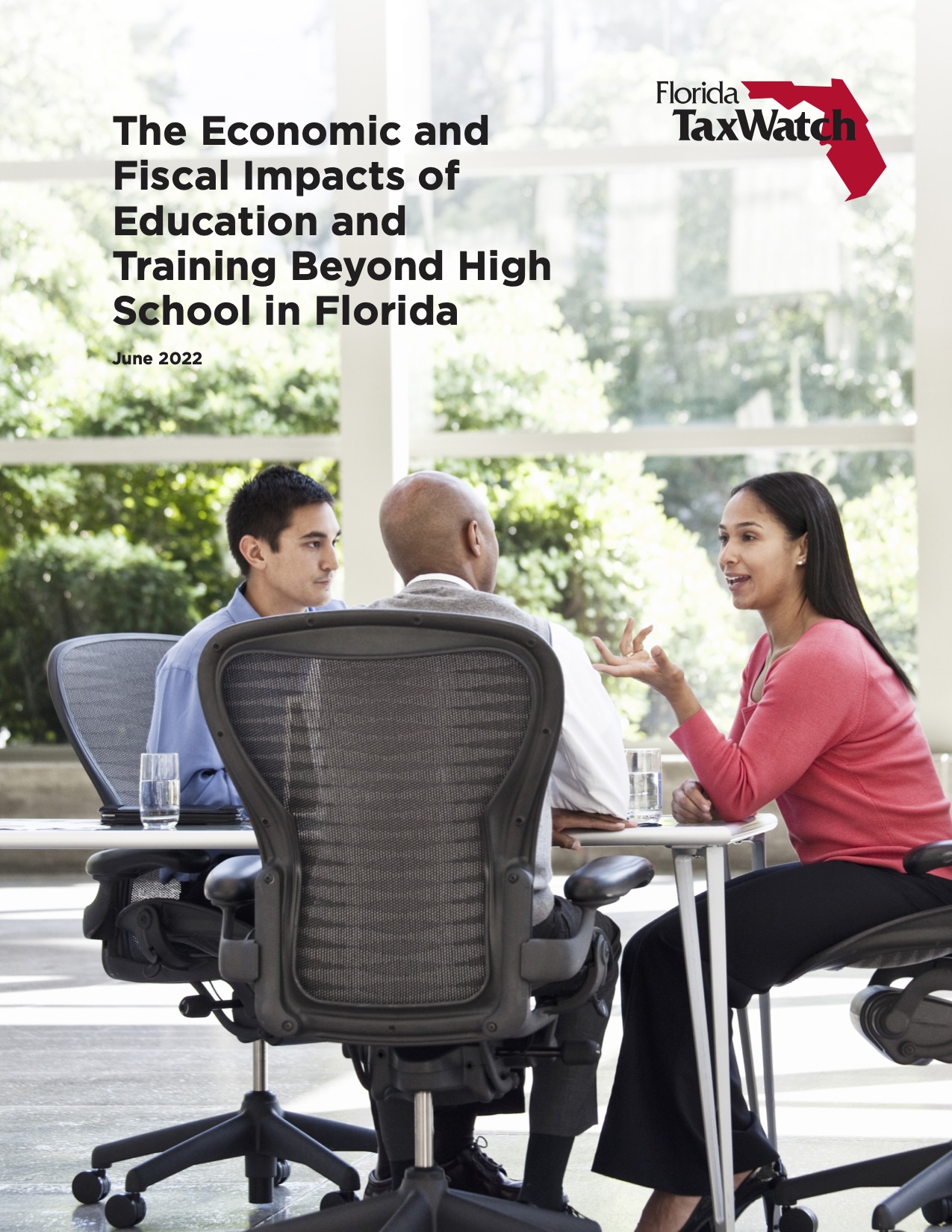The Economic and Fiscal Impacts of Education and Training Beyond High School in Florida

In 2019, with the SAIL to 60 Initiative, Florida aimed for 60 percent of working-age Floridians to hold a workforce specialization, whether from a certificate, credential, training, or degree. Currently, Florida has yet to reach this goal, falling 791,000 people short, and its individual populations are working toward the goal at incomparable rates. In January 2022, Florida TaxWatch released “The Economic and Fiscal Impacts of Education and Training Beyond High School in Florida,” which identified current education achievement gaps and how these gaps impact Florida’s economy.
In this subsequent paper, Florida TaxWatch includes previous findings but also considers what is needed to reach the 60 percent target; further examines the economic, fiscal, and societal benefits of education and training beyond high school; and recommends considerations for policymakers.
If Florida’s diverse populations began achieving certificates, credentials, trainings, and degrees at similar rates, the state and its residents could expect great economic and social benefits. Specialized workers can expect better job outcomes and attract high-value industries to the state. Specialized workers garner higher earnings, with comparable achievement offering the state an additional $53.6 billion in earnings. Not only does this enable the self-sufficiency of residents but it also equates to higher spending, which further boosts the economy and can result in an estimated $4.7 billion in tax revenue. Floridians may also witness positive societal changes from a specialized workforce, including better reported health statuses, social fulfillment, greater civic engagement, and strengthened intergenerational outcomes.
Highlights on the Benefits of Training and Education Beyond High School:
- Higher earnings: By improving educational attainment across all demographic groups, the state of Florida would derive an aggregate earnings boost of $53.6 billion annually.
- Higher spending, savings, and GDP: Higher earnings across Florida’s demographic groups (due to improved educational attainment rates) would increase the state’s GDP by $58.9 billion annually.
- Increase in tax revenue: Assuming a state and local tax burden of 8.8 percent, Florida TaxWatch calculates tax revenue in Florida would increase by $4.7 billion annually due to higher educational attainment across all demographic groups.
- Decreased reliance on safety net programs: In Florida, 16 percent of workers with a high school diploma rely upon SNAP or yearly food stamps, contrasting with four percent of those with a bachelor’s degree or higher.3
- Increased health status: Among working-age Floridians, persons with an education beyond high school report better health status.
- Increased social fulfillment: Among Americans, college graduates seem more adept at maintaining close friendships and informal friends, and they are less likely to feel lonely.
- Increased community participation: Education and trainings beyond high school are connected to volunteerism, civic engagement, and participation in community groups, likely due to increased disposable income and availability of free time.
- Increased diversity for businesses: If education and trainings beyond high school extended across Florida’s diverse population, a more varied pool of candidates across specialized fields will help businesses realize staff diversity objectives.
- Greater positive intergenerational outcomes: Studies recommend a relationship between student outcomes and parents’ educational background.
Potential Barriers:
- Individuals must have a thorough understanding of likely job and earning outcomes to be motivated to succeed;
- Additional education and training can adversely affect a household’s financial stability;
- On-boarding programs and preparatory classes may be necessary to ensure an individual is ready for the academic rigors associated with additional training and education;
- Additional skills and knowledge may be required to navigate higher education and workforce credentialing systems;
- Learners may need support to balance additional learning with other responsibilities; and
- Learners need readily available resources to connect with jobs upon completion of their learning program.
Recommendations:
- Promote academic readiness throughout the education system.
- Connect current and future workers to data-informed career-planning resources.
- Expect and facilitate learning pathways that allow students multiple ways to participate in postsecondary training and education.
- Empower community-based solutions and partnerships.
- Maintain and enhance affordability of training and education beyond high school.
- Encourage the persistence of active learners and the return of “stop-out” students.
- Design, implement, and advertise learning programs that offer multiple outcomes for student success.
As Florida navigates a world forever changed by COVID-19 and technology’s rising influence, stakeholders and policymakers should contemplate the advantages of increasing educational achievement across Florida’s diverse population. Enhanced education and training beyond high school not only helps individuals accumulate wealth and build self-sufficiency but each year, it would also amount to an additional $53.6 billion in earnings, at least $58.9 billion to GDP, and $4.7 billion in tax revenue, benefiting the economic and fiscal standings of Florida.